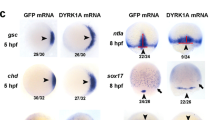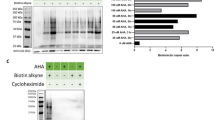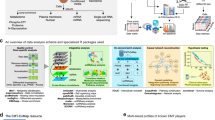Abstract
Here, we report a patient with a novel brachydactyly–syndactyly syndrome and a de novo translocation 46,XY,t(4;6)(q12;p23). We mapped the breakpoint and identified genes in the breakpoint region. One of the genes on chromosome 6, the membrane-associated O-acetyl transferase gene 1 (MBOAT1), was disrupted by the breakpoint. This gene consists of 13 exons and encodes a protein of 495 amino acids. MBOAT1 is predicted to be a transmembrane protein and belongs to the superfamily of membrane-bound O-acyltransferases. These proteins transfer organic compounds, usually fatty acids, onto hydroxyl groups of membrane-embedded targets. Identification of the transferred acyl group and the target may reveal the signaling pathways altered in this novel brachydactyly–syndactyly syndrome.
Similar content being viewed by others
Log in or create a free account to read this content
Gain free access to this article, as well as selected content from this journal and more on nature.com
or
References
Bell J : On brachydactyly (BD) and symphalangism; in: Penrose L (ed): Treasury of Human Inheritance. London: Cambridge University Press, 1951; Vol 5, pp 1–31.
Dauwerse JG, Jumelet EA, Wessels JW et al: Extensive cross-homology between the long and short arm of chromosome 16 may explain leukemic inversions and translocations. Blood 1992; 79: 1299–1304.
Giles RH, Petrij F, Dauwerse JG et al: Construction of a 1.2-Mb contig surrounding and molecular analysis of, the human CREB-binding protein (CBP/CREBBP) gene on chromosome 16p13. Genomics 1997; 42: 96–114.
Breuning MH, Snijdewint FGM, Brunner H et al: Map of 16 polymorphic loci on the short arm of chromosome 16 close to the polycystic kidney disease gene (PKD1). J Med Genet 1990; 27: 603–613.
Dauwerse JG, Die-Smulders CE, Bakker E, Breuning MH, Peters DJ : Heterozygous truncating mutation in the human homeobox gene GSH2 has no discernable phenotypic effect. J Med Genet 2002; 39: 686–688.
Datson NA, van de Vosse E, Dauwerse HG, Bout M, van Ommen GJ, den Dunnen JT : Scanning for genes in large genomic regions: cosmid-based exon trapping of multiple exons in a single product. Nucleic Acids Res 1996; 24: 1105–1111.
Soares MB, Bonaldo MF, Jelene P, Su L, Lawton L, Efstratiadis A : Construction and characterization of a normalized cDNA library. Proc Natl Acad Sci USA 1994; 91: 9228–9232.
Hofmann K : A superfamily of membrane-bound O-acyltransferases with implications for wnt signaling. Trends Biochem Sci 2000; 25: 111–112.
Chamoun Z, Mann RK, Nellen D et al: Skinny hedgehog, an acyltransferase required for palmitoylation and activity of the hedgehog signal. Science 2001; 293: 2080–2084.
Micchelli CA, The I, Selva E, Mogila V, Perrimon N : Rasp, a putative transmembrane acyltransferase, is required for Hedgehog signaling. Development 2002; 129: 843–851.
Zhai L, Chaturvedi D, Cumberledge S : Drosophila wnt-1 undergoes a hydrophobic modification and is targeted to lipid rafts, a process that requires porcupine. J Biol Chem 2004; 279: 33220–33227.
Gao B, Guo J, She C et al: Mutations in IHH, encoding Indian hedgehog, cause brachydactyly type A-1. Nat Genet 2001; 28: 386–388.
St Jacques B, Hammerschmidt M, McMahon AP : Indian hedgehog signaling regulates proliferation and differentiation of chondrocytes and is essential for bone formation. Genes Dev 1999; 13: 2072–2086.
Lai LP, Mitchell J : Indian hedgehog: its roles and regulation in endochondral bone development. J Cell Biochem 2005; 96: 1163–1173.
Acknowledgements
We thank clinicians and patients for their cooperation and Professor Brunner, Dr Fischer, Dr Tuerlings, the late Professor Winter and Professor Zabel for referral of patients.
Author information
Authors and Affiliations
Corresponding author
Additional information
Supplementary Information accompanies the paper on European Journal of Human Genetics website (www.nature.com/ejhg)
Supplementary information
Rights and permissions
About this article
Cite this article
Dauwerse, J., de Vries, B., Wouters, C. et al. A t(4;6)(q12;p23) translocation disrupts a membrane-associated O-acetyl transferase gene (MBOAT1) in a patient with a novel brachydactyly–syndactyly syndrome. Eur J Hum Genet 15, 743–751 (2007). https://doi.org/10.1038/sj.ejhg.5201833
Received:
Revised:
Accepted:
Published:
Issue date:
DOI: https://doi.org/10.1038/sj.ejhg.5201833
Keywords
This article is cited by
-
Homozygous variants in the HEXB and MBOAT7 genes underlie neurological diseases in consanguineous families
BMC Medical Genetics (2019)



